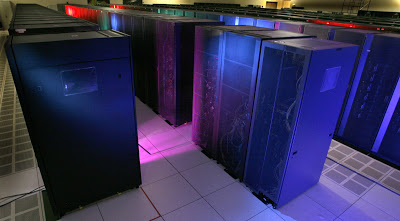
Just days after the announcement of the first sustained petaflop supercomputer (based on the Linpack computer standard, Japan has had a petaflop computer but not using the Linpack standard) Los Alamos researchers used PetaVision software on the Roadrunner supercomputer to model more than a billion visual neurons surpassing the scale of 1 quadrillion computations a second (a petaflop/s).
On June 9, 2008 scientists used PetaVision to reach a new computing performance record of 1.144 petaflop/s. The achievement throws open the door to eventually achieving human-like cognitive performance in electronic computers. PetaVision only requires single precision arithmetic, whereas the official LINPACK code used to officially verify Roadrunner’s speed uses double precision arithmetic.
“Roadrunner ushers in a new era for science at Los Alamos National Laboratory,” said Terry Wallace, associate director for Science, Technology and Engineering at Los Alamos. “Just a week after formal introduction of the machine to the world, we are already doing computational tasks that existed only in the realm of imagination a
year ago.”Based on the results of PetaVision’s inaugural trials, Los Alamos researchers believe they can study in real time the entire human visual cortex–arguably a human being’s most important sensory apparatus.
Such applications include “smart” cameras that can recognize danger or an autopilot system for automobiles that could take over for incapacitated drivers in complex situations such as navigating dense urban traffic.
Los Alamos National Laboratory’s computation science team working with Roadrunner includes: Craig Rasmussen, Charles Ferenbaugh, Sriram Swaminarayan, Pallab Datta, all of Los Alamos; and Cornell Wright of IBM.
The PetaVision Synthetic Cognition team responsible for the theory and codes run on Roadrunner includes: Luis Bettencourt, Garrett Kenyon, Ilya Nemenman, John George, Steven Brumby, Kevin Sanbonmatsu, and John Galbraith, all of Los Alamos; Steven Zuker of Yale University; and James DiCarlo from Massachusetts Institute of Technology.

Brian Wang is a Futurist Thought Leader and a popular Science blogger with 1 million readers per month. His blog Nextbigfuture.com is ranked #1 Science News Blog. It covers many disruptive technology and trends including Space, Robotics, Artificial Intelligence, Medicine, Anti-aging Biotechnology, and Nanotechnology.
Known for identifying cutting edge technologies, he is currently a Co-Founder of a startup and fundraiser for high potential early-stage companies. He is the Head of Research for Allocations for deep technology investments and an Angel Investor at Space Angels.
A frequent speaker at corporations, he has been a TEDx speaker, a Singularity University speaker and guest at numerous interviews for radio and podcasts. He is open to public speaking and advising engagements.

